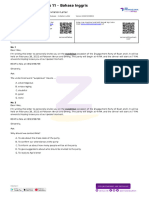0% found this document useful (0 votes)
45 views4 pagesCloud Computing
Cloud computing delivers computing services over the internet, allowing organizations to access resources without maintaining physical infrastructure. It includes various service models such as IaaS, PaaS, and SaaS, and deployment models like public, private, and hybrid clouds. Key benefits include cost efficiency, scalability, and flexibility, while challenges involve security risks and vendor lock-in.
Uploaded by
kaushikgayakwad2003Copyright
© © All Rights Reserved
We take content rights seriously. If you suspect this is your content, claim it here.
Available Formats
Download as PDF, TXT or read online on Scribd
0% found this document useful (0 votes)
45 views4 pagesCloud Computing
Cloud computing delivers computing services over the internet, allowing organizations to access resources without maintaining physical infrastructure. It includes various service models such as IaaS, PaaS, and SaaS, and deployment models like public, private, and hybrid clouds. Key benefits include cost efficiency, scalability, and flexibility, while challenges involve security risks and vendor lock-in.
Uploaded by
kaushikgayakwad2003Copyright
© © All Rights Reserved
We take content rights seriously. If you suspect this is your content, claim it here.
Available Formats
Download as PDF, TXT or read online on Scribd
/ 4























































































